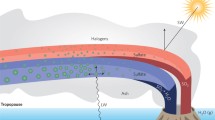Abstract
The dynamics of formation of a stratospheric aerosol is traced on the basis of a one-dimensional photochemical model of a horizontally homogeneous atmosphere allowing for only vertical transfer of impurities. Calculations show that below 30 km sulfur is mainly in the form of CSO, whereas at higher altitudes it is in the form of sulfuric acid.
Similar content being viewed by others
References
Volcanos, Stratospheric Aerosol, and Earth’s Climate [in Russian], Leningrad (1986).
Aerosol and Climate [in Russian], Leningrad (1991).
M. Wofsy, J. C. McConnell, and M. B. McElroy,J. Geophys. Res.,47, 4477–4488 (1972).
D. F. Strobel,J. Geophys. Res.,76, 8384–8417 (1971).
G. Brasier and S. Solomon,Aeronomy of Middle Atmosphere [Russian translation], Leningrad (1987).
Ku-Nan Liou,Principles of Radiative Processes in Atmosphere [Russian translation], Leningrad (1984).
Rights and permissions
About this article
Cite this article
Kas’kova, S.I., Romanov, G.S. Chemical processes in the earth’s atmosphere disturbed by volcanic ejection. J Eng Phys Thermophys 72, 1170–1178 (1999). https://doi.org/10.1007/BF02699466
Received:
Issue Date:
DOI: https://doi.org/10.1007/BF02699466




